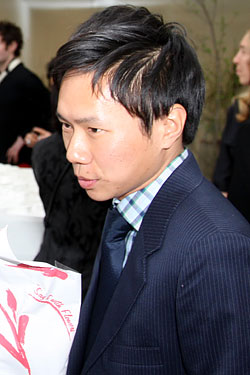
New York artists will play an outsize role in the influential Venice Biennale, set to open in Italy June 6. ÔÇ£There will be a lot of American artists in the exhibition and a lot of them live and work in New York City,ÔÇØ announced Daniel Birnbaum, the showÔÇÖs director and curator, as he introduced the artistsÔÇÖ roster today at the Italian Cultural Institute on Park Avenue.
The Venice Biennale, one of the grandest stops on the art-world grand tour, is something of a Miss America pageant for art. Nations bring work by a single artist (the U.S. picked Bruce Nauman, in a show curated by the Philadelphia Museum of Art), and a much-debated ÔÇ£best of showÔÇØ is awarded. On top of that, a huge separate exhibition of 100 or so artists attempts to offer a snapshot of the current contemporary-art world. This yearÔÇÖs Biennale is the largest ever, with 77 nations hosting art pavilions, including first-time exhibitors United Arab Emirates and the Vatican (now in negotiations). ÔÇ£ItÔÇÖs the biggest art show in the world,ÔÇØ notes Birnbaum.
Generally, the Venice Biennale has tremendous impact on the market and on artistsÔÇÖ careers (as Jerry Saltz has noted). Biennale president Paolo Baratta stressed that BirnbaumÔÇÖs job is ÔÇ£not to give the latest quotation on the market for contemporary art.ÔÇØ But many deals started in Venice are consummated at the huge Art Basel fair that opens in Switzerland later the same week.
Birnbaums hometown picks include political artist and peace activist Paul Chan, best known for his 7 Lights multimedia show at the New Museum; local filmmaker and artist Tony Conrad; Yoko Ono, whose work will include performance and poetry and who will receive a Golden Lion for lifetime achievement at the show; and artist duo Guyton\Walker, who will do very painterly things  big paintings and will be prominently displayed in the show, said the curator.
Some of the other New York artists who got into the Biennale exhibition are Joan Jonas, Rachel Harrison, Spencer Finch, Rirkrit Tiravanija, and Jorge Ortero-Pailos. (German and L.A. artists also make up large chunks of the show, with a smattering of Italian, Indian, Japanese, Russian, and Latin American artists rounding out the roster.)
As for any trend shifts the show might signal, in general, the works with which Birnbaum illustrated his introduction were ÔÇ£painterly,ÔÇØ by his own description, and featured themes of lightness and floating, along with architectural elements.
So far the economy hasnÔÇÖt impacted the Biennale much, said Birnbaum, except that perhaps artists are leaning toward ÔÇ£things that are very difficult to package, buy, and sell ÔÇö but thatÔÇÖs not really new.ÔÇØ Baratta said the financial situation had meant ÔÇ£more night flights and one star less in our choice of hotels.ÔÇØ

